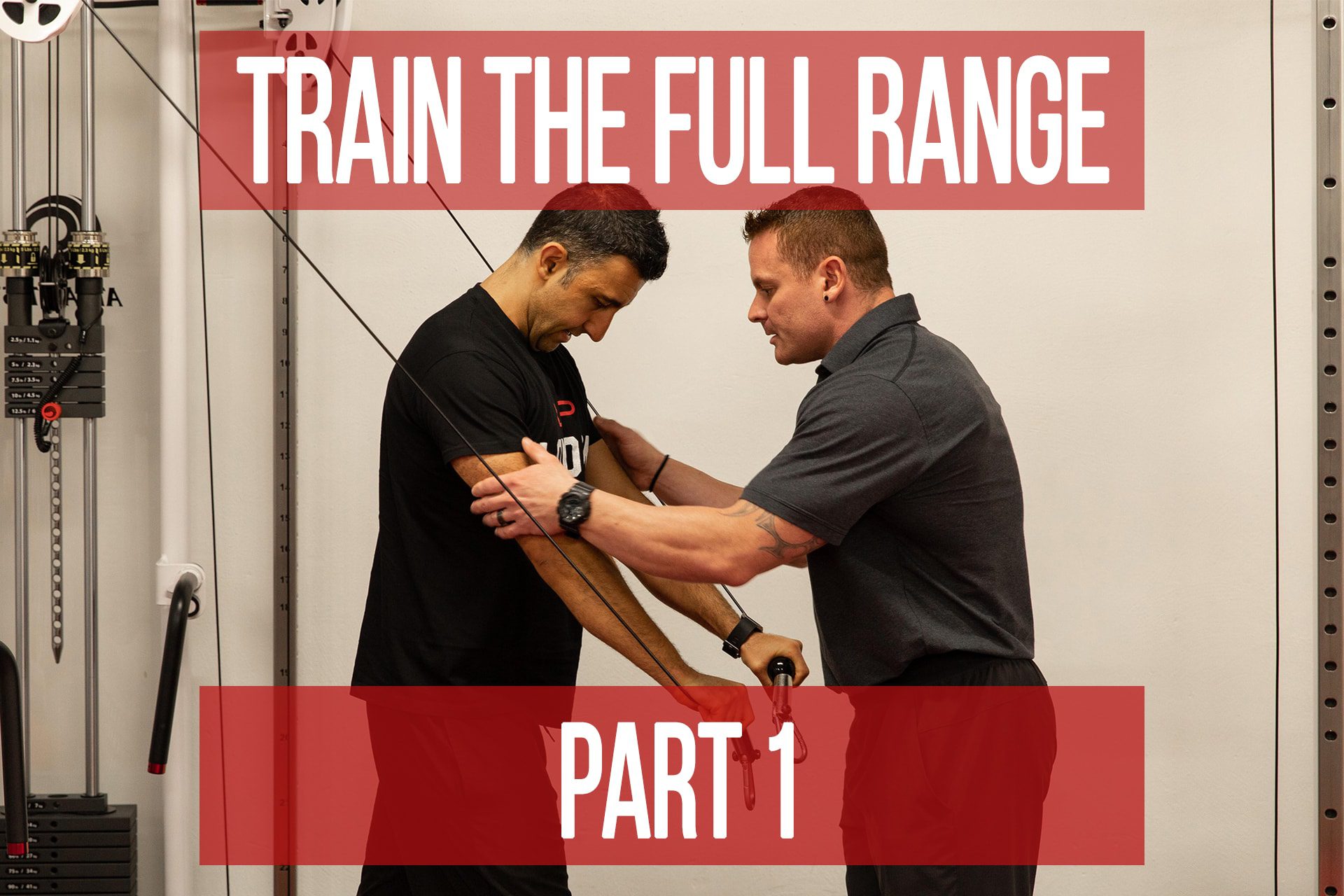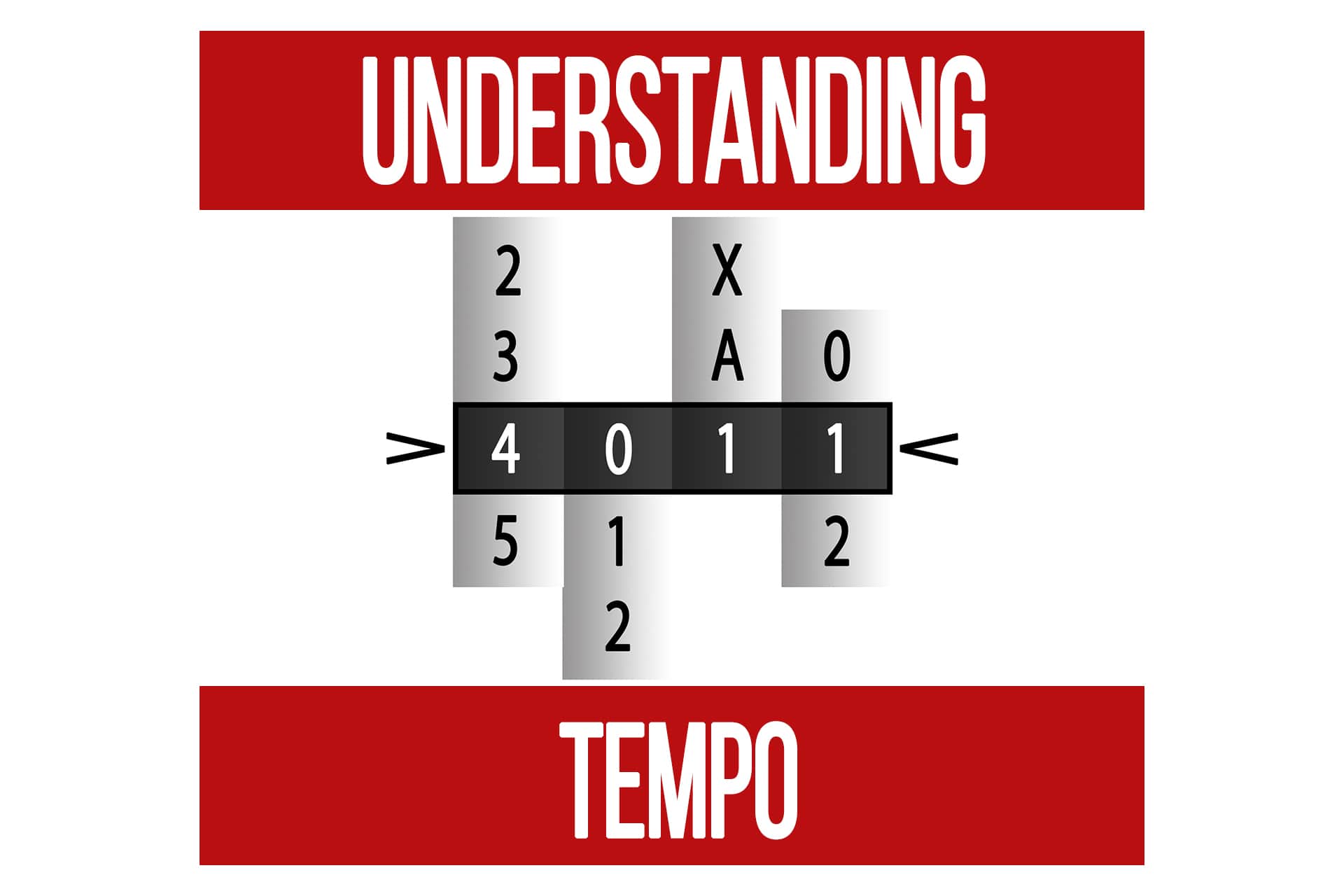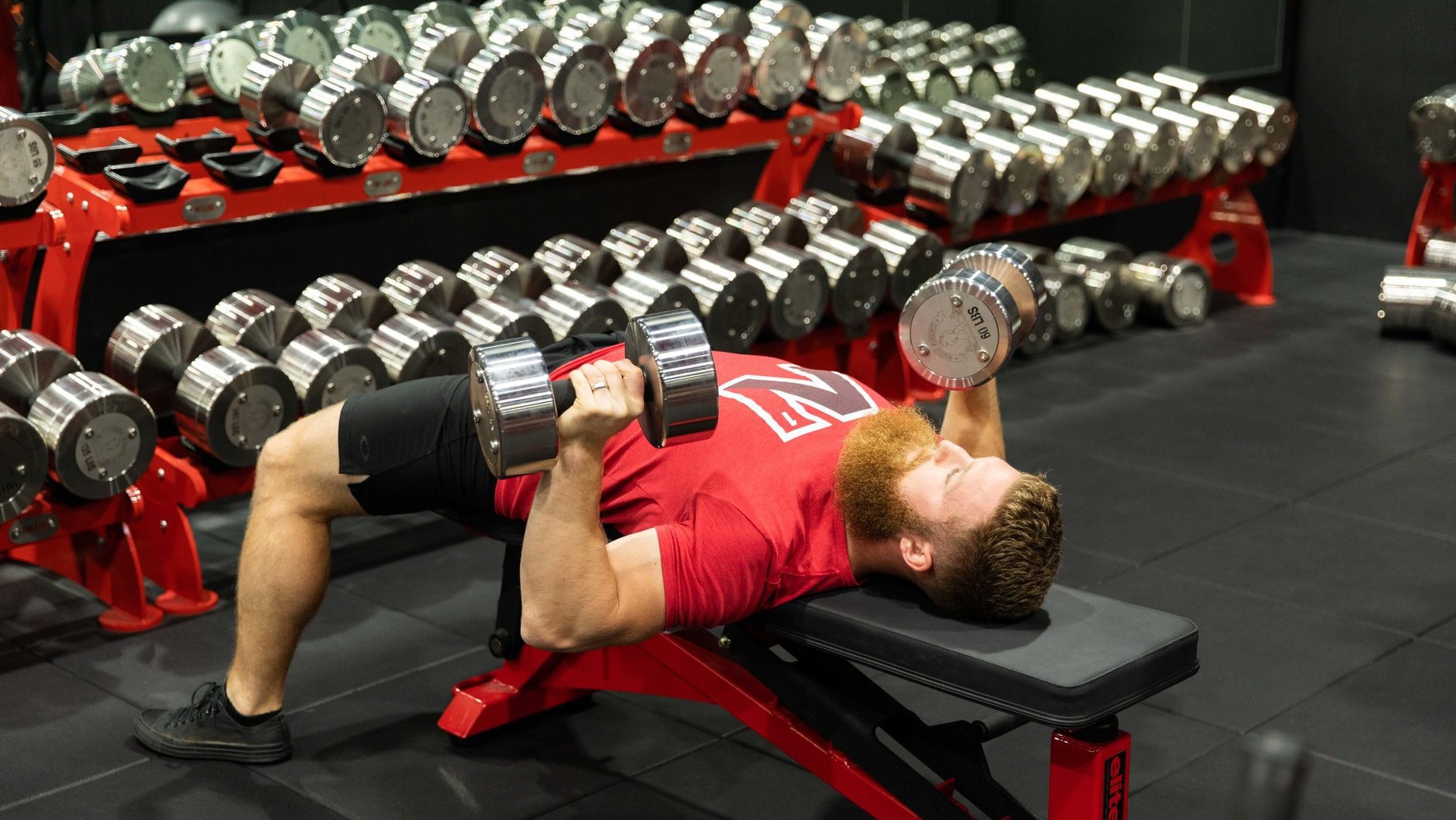The 3 Main Types of Range of Motion
n1 training
Range of motion is the distance or degree of which you can move a joint or muscle. This will vary depending on the conditions, whether the limb is being moved passively, actively, or under load. A joint will have a large varying range of motion, whereas a muscle’s effective training range of motion will be more specific and subject to a more specific path of motion or vector.
Passive ROM:
Passive range of motion is achieved in the absence of internal tension, by an external force such as gravity, and stretch strap or a partner/coach/therapist. For example if you bend down to reach your toes and you relax and let gravity pull you down, this would be passive ROM. Similarly, if you were lying on your back and someone was lifting your leg into a hamstring stretch would also be passive ROM. Passive ROM is most often used
Active ROM:
Active range of motion is achieved using your own muscular contractions, with no external assistance, other than maybe reducing limb load in some cases. Following the first examples, active ROM would be how far you could lift your leg into a hamstring stretch position by contracting your hip flexors and knee extensors. This will almost always be less than passive ROM because you have to create tension around the joint to stabilize it through motion.
Trainable ROM:
Trainable range of motion is the active range of motion you can achieve under specific loading conditions. Strength becomes a factor in how much range of motion we are actively capable when we are under loads. Trainable ROM will be limited by weak links in strength and stability under loads. For example, in a squatting motion, if the quads are weaker in proportionate to the demands, you may end up driving the hips back to put more load on the posterior chain. This will often result in less knee flexion in the exercise than you would be able to accomplish under lighter loading conditions. In certain exercises the ability to maintain balance may also be a factor. For example you may be able to achieve a different ROM in a goblet squat where the weight serves as a counterbalance, versus a barbell back squat.
Joint ROM:
A joint’s range of motion is limited by its structure, and the passive and contractile tissues around it. There will be a range of passive, active, and trainable motions a joint can perform. A very mobile joint like the shoulder will have a wide variety of motions, whereas a joint like the knee will have one primary motion (flexion/extension). Throughout a joint’s range of motion, the motion and force may be produced by a variety of different muscles in an integrated fashion.
Isolated Muscle ROM:
A muscles isolated range of motion is going to have a specific path of motion or vector. This vector is the direct path from a muscle’s two extreme end ranges of motion (lengthened-shortened). In this path and range the isolated muscle will be the primary producer of the motion and force. This is the ideal path and range of motion to produce stimulus in the muscle. Deviating from the muscle’s specific path of motion will shift the training demands to other muscles, decreasing the stimulus on the target muscle. When the goal is to create a stimulus in a specific muscle rather than train the motor pattern of an integrated function, you want to follow the specific path of motion of that muscle, and work within the trainable range of motion along that path.
Sport Defined ROM:
This is a predetermined range of motion that is required as a standardization for a sport or competitive qualification, powerlifting for example. This may be more or less than an individual’s active range of motion. These motions are often not isolated muscular motions. There can be consequences to mobility, function and joint/tissue health when these sport motions are outside your active/trainable ROM. Because of that, it is important to understand that to improve performance in a sport specific range of motion does not require you to do all your training in that ROM, or even use that ROM in all training blocks.
Training outside your active/trainable ROM results in increased compensatory recruitment by muscles that had either a not direct but synergistic, or stabilizing role, forcing them to become force producers in these positions where the primary muscles have lost some of their abilities to contribute to the motion. This creates more stress on the joints and surrounding tissues, and when done repeatedly can actually lead to neuromuscular adaptations that try to guard the joint by restricting ROM even more. If you start losing passive/active ROM you may be over performing movements outside your trainable ROM.
Fortunately limiting the sport specific ROM to only what is needed for performance and performing more movements in a trainable ROM can help maintain or improve mobility and joint health. So many individuals can manage this with good programming and technique. One approach I think is possibly more injurious is the implementation of stretching to maintain ROM while continuing to do a lot of volume outside your trainable ROM. Now this is not the fault of the stretching itself, but the fact that you are using a passive modality that allows you to do more active work outside your trainable ROM. Stretching does not actually lengthen tissues, but is working against the neuromuscular adaptations that would otherwise be restricting range. In the case of stretching however it’s giving you access to these ranges without improving function or strength in them. To better prevent injury, you want to improve strength and function over greater ranges of motion by doing full isolated muscle rom exercises for the muscles around that joint. The proper incorporation of stretching or mobility work can be beneficial but should not be used to enable poor training practices.
In Depth and Application:
Passive range of motion is most commonly used in a therapy setting to look for asymmetries between sides. Asymmetrical passive ROM can provide information about the current structural and/or neurological conditions affecting a joint and its surrounding muscles. In many cases passive ranges are beyond the range of motion achieved in most loaded training motions. Asymmetries and significantly reduced passive range of motion are usually the result of an injury or chronic issue that has led to a neurological adaptation to restrict motion.
Active range or motion is the best predictor of what the maximum trainable range of motion could be. The closer your trainable ROM to your active ROM, the more likely you have good balance of strength, stability, and neuromuscular coordination of a movement. In addition, having an active range of motion that is close to your passive ROM (provided it’s symmetrical) is also a positive indicator of good neuromuscular function. It is normal though that the active ROM will always be a little less than the passive, because in an active state you are creating compressive and co-contraction forces around the joint. The reality is, it would not be ideal if we were taking our joints into the structural limits under load anyway. That would be incredibly inefficient in most cases from a force production standpoint, and drastically more injurious. When functioning properly, our neuromuscular system is not going to take us to structural end ranges.
Forced ROM:
In some cases because of the nature of loading in a training situation, you may be pushed past your active ROM if you let the weight push you past it, into a loaded stretch. More often than not in these cases, this is going to lead to a large spike in compensatory muscle recruitment. That all together is not a great recipe for training stimulus, or safety. It is possible that active ROM increases as you perform a movement over reps, sets. But that is different than simply allowing a load to push you beyond the range you could achieve actively into a forced ROM.
When there is a desire to have a greater ROM, this can be very misleading. As that load pushes you outside of your active range of motion, more force is shifted onto surrounding muscle groups and passive structures rather than the prime movers. In fact in an effort to protect the joint, the primary torque producing muscles around the joint may be inhibited by the nervous system in an attempt to protect the joint integrity. This can actually lead to neurological adaptations that decrease passive and active ROM over time.
When measuring the lengthened portion of a movement actively, you are contracting the antagonist muscles and your brain is regulating how far that antagonist can pull the target tissue into a stretch before it determines the integrity of the joint/tissues has reached its limit, and then it does not allow you to shorten that antagonist any further. So the active ROM is in a sense the maximum range that your body currently has good neuromuscular control over.
Doing light exercises with the goal of improving neuromuscular function to open up more range may be beneficial. But when using training loads meant to drive a physiological stimulus, you should stay within the active ROM.
We know trainable range of motion should not exceed active ROM, but that doesn’t mean it will be the full active rom. Remember the factor in trainable ROM is load. As soon as load starts to exceed the threshold of the prime movers or any of the stabilizers, the motion will begin to be altered if it is continued. This may or may not be an acceptable alteration. For example in the squatting example mentioned in the early part of the article where if the knee extensor threshold is met, the squat may become more hip dominant. In some cases a person may still be able to achieve full rom if their body segments and mobility allow them to still hit depth in just a more hip dominant squat, which may still be ok if the goal was not quadricep isolation. If the goal was to train more of the hip musculature this also may be fine. However in the case where you were trying to target the quads, and the load now causes loss of ROM at the knee, you are possibly decreasing the effectiveness of the exercise and increasing non specific stress by just adding load. Or in the case after adding load you have to round at the low back in order to get the range of motion of the knee, you are exceeding the trainable ROM for the load being used.
Whether you use joint versus isolated muscle range of motion to guide your training should depend on your goal. Are you training a muscle or a motion? If you are training a motion, it may not be isolated to a specific muscle, but you should still make note of the primary force producers and their specific ROM. This can help you improve your technique for better overall performance if you can make the motion align better and stay within the range of the major force producers.
If your goal is a local physiological stimulus for a muscle, then isolated muscle ROM should be your guide. Remember this is path of motion specific, so you need to understand your functional anatomy. Utilizing the correct path and range of motion for a specific tissue will increase the magnitude and duration of tension and metabolic work in that specific tissue. The amount of stimulus change as you deviate from these paths of motion will vary quite a bit across different muscles, joints, and exercises. For example the two gastroc bellies and the soleus have slightly different paths of motion, but because they are very similar and the joint is fairly simple, you are going to achieve some degree of stimulus in all of the during any plantarflexion exercise. So as long as you are training close to failure, you may get sufficient stimulus in all of them. That doesn’t mean it can’t be more isolated or optimal by being more specific with your path and range, but in this case there is a higher tolerance to inaccuracy while still achieving a training stimulus.
Now if we take a more complex joint like the shoulder that has a lot of motion, it is very easy to significantly lose stimulus in the target muscle by going outside its specific path or range. For example performing a rowing or pulling movement with too wide of an arm path can drastically shift the force demands from the lats to the upper back and rear delt muscles. The lats may still be doing some work, but no longer enough to produce the stimulus needed for positive adaptations. Looking deeper, the lats have 3 divisions, and each of those has a specific path and range of motion. So if you are trying to bring up a specific portion of that muscle, you will get much better results using the specific path and range for the respective division.
When it comes to physique based goals, there is a tremendous amount of efficacy and efficiency gained by training in isolated muscle ROM. Unfortunately most people do not understand anatomy or biomechanics well enough to assess their ROM and improve their technique. Even more unfortunate is the misinformation out there that leads people to believe that increased range of motion of any kind is better. This leads to people focusing on motions that aren’t in the joints or tissues they are targeting and in some cases aren’t even occurring in the body. They may be focused on implement range of motion (how far a bar/handle etc is moving). You will often see these people going through huge total body motions simply to create motion in the implement and often not even approaching the full trainable ROM of the target tissue. The irony is that these people are often training their target tissues through less ROM, while blindly thinking more ROM = better. You will often find individuals that train in this nature require the use of momentum and/or high reps in many motions to “feel” them properly. If you can not achieve a targeted stimulus in a controlled or high intensity (low rep) condition, it is likely because your path/range of motion is not specific enough and the movement is reaching task failure before you can achieve significant local stimulus. If you are doing motions that are targeted, you can create isolated stimuli at higher intensities, which opens up the programming playbook more and leads to greater results and happier joints.
Range of motion is the distance or degree of which you can move a joint or muscle. This will vary depending on the conditions, whether the limb is being moved passively, actively, or under load. A joint will have a large varying range of motion, whereas a muscle’s effective training range of motion will be more specific and subject to a more specific path of motion or vector.
Passive ROM
Passive range of motion is achieved in the absence of internal tension, by an external force such as gravity, and stretch strap or a partner/coach/therapist. For example if you bend down to reach your toes and you relax and let gravity pull you down, this would be passive ROM. Similarly, if you were lying on your back and someone was lifting your leg into a hamstring stretch would also be passive ROM.
Active ROM
Active range of motion is achieved using your own muscular contractions, with no external assistance, other than maybe reducing limb load in some cases. Following the first examples, active ROM would be how far you could lift your leg into a hamstring stretch position by contracting your hip flexors and knee extensors. This will almost always be less than passive ROM because you have to create tension around the joint to stabilize it through motion.
Trainable ROM
Trainable range of motion is the active range of motion you can achieve under specific loading conditions. Strength becomes a factor in how much range of motion we are actively capable when we are under loads.
Trainable ROM will be limited by weak links in strength and stability under loads. For example, in a squatting motion, if the quads are weaker in proportionate to the demands, you may end up driving the hips back to put more load on the posterior chain. This will often result in less knee flexion in the exercise than you would be able to accomplish under lighter loading conditions.
In certain exercises the ability to maintain balance may also be a factor. For example you may be able to achieve a different ROM in a goblet squat where the weight serves as a counterbalance, versus a barbell back squat.
Joint ROM
A joint’s range of motion is limited by its structure, and the passive and contractile tissues around it. There will be a range of passive, active, and trainable motions a joint can perform. A very mobile joint like the shoulder will have a wide variety of motions, whereas a joint like the knee will have one primary motion (flexion/extension).
Throughout a joint’s range of motion, the motion and force may be produced by a variety of different muscles in an integrated fashion.
Isolated Muscle ROM
A muscle’s isolated range of motion is going to have a specific path of motion or vector. This vector is the direct path from a muscle’s two extreme end ranges of motion (lengthened-shortened). In this path and range the isolated muscle will be the primary producer of the motion and force.
This is the ideal path and range of motion to produce stimulus in the muscle. Deviating from the muscle’s specific path of motion will shift the training demands to other muscles, decreasing the stimulus on the target muscle.
When the goal is to create a stimulus in a specific muscle rather than train the motor pattern of an integrated function, you want to follow the specific path of motion of that muscle, and work within the trainable range of motion along that path.
Conditional Ranges of Motion
Sport Defined ROM
This is a predetermined range of motion that is required as a standardization for a sport or competitive qualification, powerlifting for example. This may be more or less than an individual’s active range of motion. These motions are often not isolated muscular motions.
There can be consequences to mobility, function and joint/tissue health when these sport motions are outside your active/trainable ROM. Because of that, it is important to understand that to improve performance in a sport specific range of motion does not require you to do all your training in that ROM, or even use that ROM in all training blocks.
Training outside your active/trainable ROM results in increased compensatory recruitment by muscles that had either a not direct but synergistic, or stabilizing role, forcing them to become force producers in these positions where the primary muscles have lost some of their ability to contribute to the motion. This creates more stress on the joints and surrounding tissues, and when done repeatedly can actually lead to neuromuscular adaptations that try to guard the joint by restricting ROM even more. If you start losing passive/active ROM you may be over performing movements outside your trainable ROM.
Fortunately limiting the sport specific ROM to only what is needed for performance and performing more movements in a trainable ROM can help maintain or improve mobility and joint health. So, many individuals can manage this with good programming and technique.
One approach I think is possibly more injurious is the implementation of stretching to maintain ROM while continuing to do a lot of volume outside your trainable ROM. Now this is not the fault of the stretching itself, but the fact that you are using a passive modality that allows you to do more active work outside your trainable ROM. Stretching does not actually lengthen tissues, but is working against the neuromuscular adaptations that would otherwise be restricting range. In the case of stretching however it’s giving you access to these ranges without improving function or strength in them.
To better prevent injury, you want to improve strength and function over greater ranges of motion by doing full isolated muscle ROM exercises for the muscles around that joint. The proper incorporation of stretching or mobility work can be beneficial but should not be used to enable poor training practices.
Forced ROM
In some cases because of the nature of loading in a training situation, you may be pushed past your active ROM if you let the weight push you past it, into a loaded stretch. More often than not in these cases, this is going to lead to a large spike in compensatory muscle recruitment. That all together is not a great recipe for training stimulus, or safety. It is possible that active ROM increases as you perform a movement over multiple reps and sets. But that is different than simply allowing a load to push you beyond the range you could achieve actively into a forced ROM.
When there is a desire to have a greater ROM, this can be very misleading. As that load pushes you outside of your active range of motion, more force is shifted onto surrounding muscle groups and passive structures rather than the prime movers. In fact in an effort to protect the joint, the primary torque producing muscles around the joint may be inhibited by the nervous system in an attempt to protect the joint integrity. This can actually lead to neurological adaptations that decrease passive and active ROM over time.
In Depth & Application
Passive range of motion is most commonly used in a therapy setting to look for asymmetries between sides. Asymmetrical passive ROM can provide information about the current structural and/or neurological conditions affecting a joint and its surrounding muscles. In many cases passive ranges are beyond the range of motion achieved in most loaded training motions. Asymmetries and significantly reduced passive range of motion are usually the result of an injury or chronic issue that has led to a neurological adaptation to restrict motion.
Active range of motion is the best predictor of what the maximum trainable range of motion could be. The closer your trainable ROM to your active ROM, the more likely you have good balance of strength, stability, and neuromuscular coordination of a movement. In addition, having an active range of motion that is close to your passive ROM (provided it’s symmetrical) is also a positive indicator of good neuromuscular function.
It is normal though that the active ROM will always be a little less than the passive, because in an active state you are creating compressive and co-contraction forces around the joint. The reality is, it would not be ideal if we were taking our joints into the structural limits under load anyway. That would be incredibly inefficient in most cases from a force production standpoint, and drastically more prone to injury. When functioning properly, our neuromuscular system is not going to take us to structural end ranges.
When measuring the lengthened portion of a movement actively, you are contracting the antagonist muscles and your brain is regulating how far that antagonist can pull the target tissue into a stretch before it determines the integrity of the joint/tissues has reached its limit, and then it does not allow you to shorten that antagonist any further. So the active ROM is in a sense the maximum range that your body currently has good neuromuscular control over.
Doing light exercises with the goal of improving neuromuscular function to open up more range may be beneficial. But when using training loads meant to drive a physiological stimulus, you should stay within the active ROM.
We know trainable range of motion should not exceed active ROM, but that doesn’t mean it will be the full active ROM. Remember the factor in trainable ROM is load. As soon as load starts to exceed the threshold of the prime movers or any of the stabilizers, the motion will begin to be altered if it is continued. This may or may not be an acceptable alteration.
In the squatting example mentioned in the early part of the article, where if the knee extensor threshold is met, the squat may become more hip dominant. In some cases a person may still be able to achieve full ROM if their body segments and mobility allow them to still hit depth in just a more hip dominant squat, which may still be ok if the goal was not significant quadricep bias. If the goal was to train more of the hip musculature this also may be fine. However in the case where you were trying to target the quads, and the load now causes loss of ROM at the knee, you are possibly decreasing the effectiveness of the exercise and increasing non specific stress by just adding load. Or in the case after adding load you have to round at the low back in order to get the range of motion of the knee, you are exceeding the trainable ROM for the load being used.
Whether you use joint versus isolated muscle range of motion to guide your training should depend on your goal. Are you training a muscle or a motion? If you are training a motion, it may not be isolated to a specific muscle, but you should still make note of the primary force producers and their specific ROM. This can help you improve your technique for better overall performance if you can make the motion align better and stay within the range of the major force producers.
If your goal is a local physiological stimulus for a muscle, then isolated muscle ROM should be your guide. Remember this is path of motion specific, so you need to understand your functional anatomy. Utilizing the correct path and range of motion for a specific tissue will increase the magnitude and duration of tension and metabolic work in that specific tissue. The amount of stimulus change as you deviate from these paths of motion will vary quite a bit across different muscles, joints, and exercises.
For example, the two gastrocnemius bellies and the soleus have slightly different paths of motion, but because they are very similar and the joint is fairly simple, you are going to achieve some degree of stimulus in all of the during any plantarflexion exercise. So as long as you are training close to failure, you may get sufficient stimulus in all of them. That doesn’t mean it can’t be more isolated or optimal by being more specific with your path and range, but in this case there is a higher tolerance to inaccuracy while still achieving a training stimulus.
Now if we take a more complex joint like the shoulder that has a lot of motion, it is very easy to significantly lose stimulus in the target muscle by going outside its specific path or range. For example performing a rowing or pulling movement with too wide of an arm path can drastically shift the force demands from the lats to the upper back and rear delt muscles. The lats may still be doing some work, but no longer enough to produce the stimulus needed for positive adaptations. Looking deeper, the lats have 3 divisions, and each of those has a specific path and range of motion. So if you are trying to bring up a specific portion of that muscle, you will get much better results using the specific path and range for the respective division.
When it comes to physique based goals, there is a tremendous amount of efficacy and efficiency gained by training in isolated muscle ROM. Unfortunately most people do not understand anatomy or biomechanics well enough to assess their ROM and improve their technique. Even more unfortunate is the misinformation out there that leads people to believe that increased range of motion of any kind is better. This leads to people focusing on motions that aren’t in the joints or tissues they are targeting and in some cases aren’t even occurring in the body. They may be focused on implement range of motion (how far a bar/handle etc is moving). You will often see these people going through huge total body motions simply to create motion in the implement and often not even approaching the full trainable ROM of the target tissue. The irony is that these people are often training their target tissues through less ROM, while blindly thinking more ROM = better. You will often find individuals that train in this nature require the use of momentum and/or high reps in many motions to “feel” them properly. If you can not achieve a targeted stimulus in a controlled or high intensity (low rep) condition, it is likely because your path/range of motion is not specific enough and the movement is reaching task failure before you can achieve significant local stimulus. If you are doing motions that are targeted, you can create isolated stimuli at higher intensities, which opens up the programming playbook more and leads to greater results and happier joints.
Key Advice
There are two keys to developing the most efficient motor unit recruitment patterns.
- Always training in the appropriate ROM for the load you are using.
- Proper execution of the exercise through proper intent and technique.
Have a Question On This Content?
Please Log In to Submit Your Question

Popular Pages
Learn & Train With Us
Add N1 Training to your Homescreen!

Please log in to access the menu.





